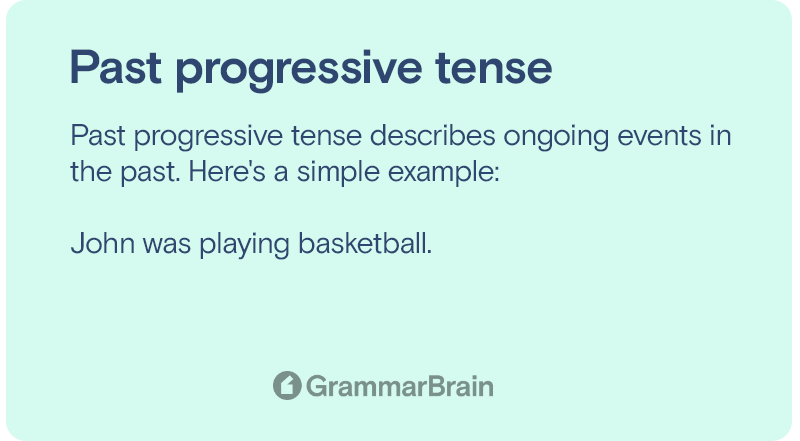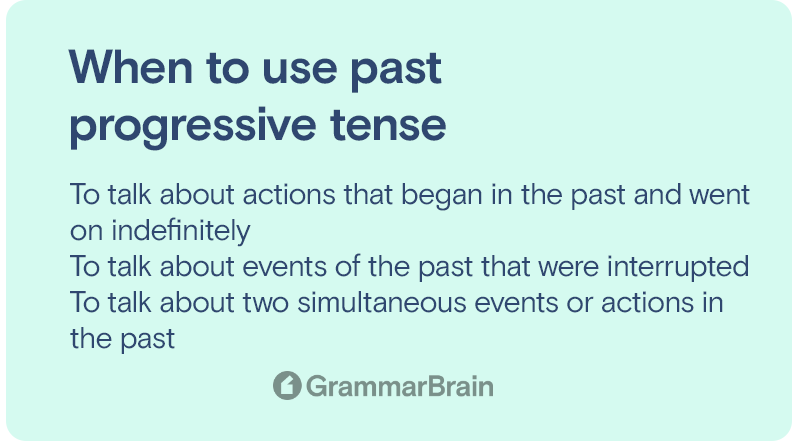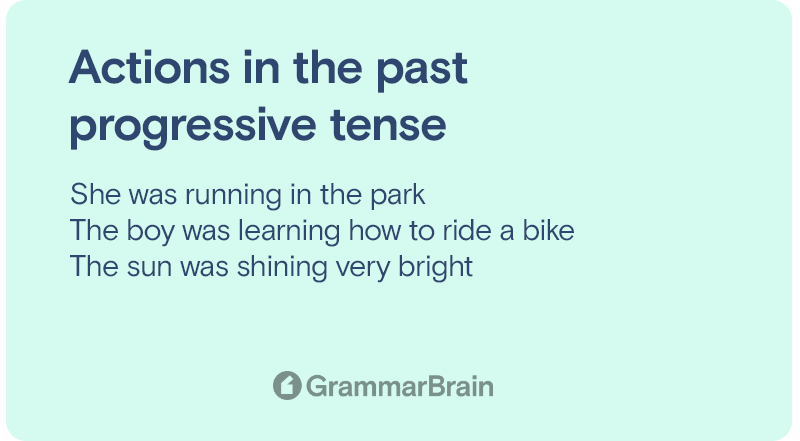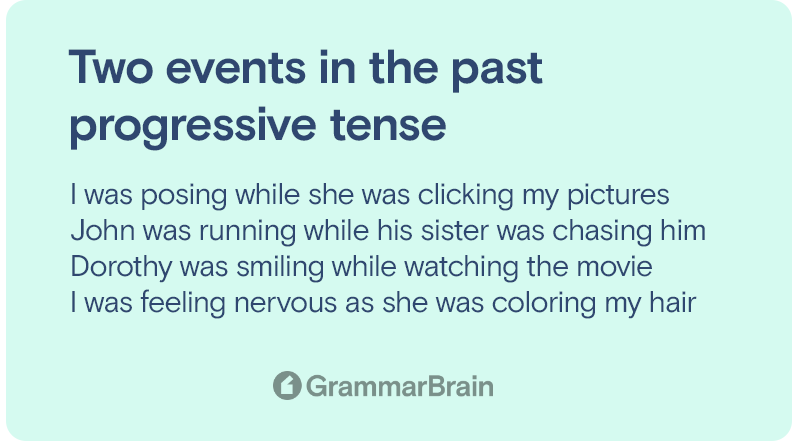What is past progressive tense? And how does it work with the other verb tenses? What is the purpose of it’s grammatically function? These are all great questions that English writers, speakers, and educators have regarding the past progressive tense.
Get answers to these question and more in this English grammar guide…

What is past progressive tense?
Past progressive tense describes ongoing events in the past. Here’s a simple example:
Let’s break down the sentence:
Who was playing?
John
What was he playing?
Basketball
When was he playing basketball?
In the past (was)
Had we written John played basketball, the sentence would be in the simple past tense, not past progressive.
Whenever there’s a verb+(ing) structure in a sentence, it refers to an ongoing activity.
Example:
Mary is dancing
She is setting up the dinner table
LeBron is playing basketball
The above sentences are in the present tense, hence, they are in the present progressive tense. We can easily change them to the past progressive tense:
Mary was dancing
She was setting up the dinner table
LeBron was playing basketball
To reiterate the definition of past progressive tense: it describes ongoing (continuous) events and activities in the past.
Note: Past progressive tense is also known as past continuous tense.

How does past progressive tense compare to the other tenses?
Here is a table that shows the differences of the many verb tense forms:
| Tense | Function | Rule | Example |
| Present simple | Helps to describe habits, facts, actions, and truth that are not affected by time | Ist form of verb + s/es | He loves pizza. |
| Past simple | Helps to describe events that have happened in the past | IInd form of the verb | She wore a beautiful dress for the party. |
| Future simple | Helps to describe events that will happen in the future | Will/ shall + Ist form | He will go to New York tomorrow. |
| Present perfect | Helps to describe the relevance of past events in the present moment | Has/ have + IIIrd form of the verb | I have learned to ride a bike. |
| Past perfect | Helps to describe events that happened prior to other events in the past | Had + IIIrd form of the verb | She had finished the paper before leaving the hall. |
| Future perfect | Helps to describe events that will be completed between now and a specific point in the future | Will/ have + IIIrd form of the verb | She will have finished the book by tomorrow. |
| Present continuous | Helps to describe ongoing actions | Is/ am/ are + Ist form + ing | She is reading a book. |
| Past continuous | Helps to describe ongoing events of the past, mostly in relation to another event | Was/ were + Ist form + ing | He was driving to work when the accident happened. |
| Future continuous | Helps to describe future events that will/are expected to continue for a period of time | Will be + Ist form + ing | I will be going to meet my grandparents tomorrow. |
| Present perfect continuous | Helps to describe events that started in the past and will continue into the present | Has/ have been + Ist form + ing | She has been writing a book for the past one year. |
| Past perfect continuous | Helps to describe events that began, continued, and ended in the past | Had been + Ist form + ing | I had been working in this company for ten years when I got the promotion. |
| Future perfect continuous | Helps to describe events that began in the past but will continue until a point in the future | Will/ shall have been + Ist form + ing | I will have been doing business with her for one year. |
Use of past progressive tense (examples)
We use past progressive tense primarily in three situations:
- To talk about actions that began in the past and went on indefinitely
- To talk about events of the past that were interrupted
- To talk about two simultaneous events or actions in the past

Examples of actions that began in the past and went on indefinitely
- She was running in the park
- The boy was learning how to ride a bike
- The sun was shining very bright
While these sentences convey complete meaning, they don’t talk about the duration of the events. How long did she run in the park? How long did the sun shine brightly? These sentences don’t have the answer to such questions.

Examples of events of the past that were interrupted
- LeBron was playing basketball when it started raining
- I was trying on the new dress when my friend asked me to hurry up
- She was cooking when the phone rang
In each of the above instances, the ongoing action of the past was interrupted due to some other action. Both the action and the interruption are in the past.

Examples of sentences with two simultaneous events or actions in the past
- I was posing while she was clicking my pictures
- John was running while his sister was chasing him
- Dorothy was smiling while watching the movie
- I was feeling nervous as she was coloring my hair
There are two ongoing events from the past in each of the above examples.
Similarly, we use past progressive tense to combine two simple sentences.
For example:
She was crying. He was trying to console her.
She was crying while he was trying to console her.
It was raining. I was trying to walk back as fast as possible.
I was trying to walk back as fast as possible since it was raining.
Using past progressive tense helps us write in a more free-flowing and lucid voice. It also helps in bringing coherence and structure to sentences.
Past progressive tense is also used to denote the specific time and place of an event.
Consider the following examples:
- At 12 AM, I was trying to fall asleep
- By the end of June, I was going to the gym every day
- In 1998, she was just starting out as a singer
- By the end of the month, I was already doing better than everyone else
In all of the above examples, the use of past progressive tense allows us to pinpoint a date or time in the past. It also represents the ongoing nature of the events: trying to, going to, starting out, doing, and so on.
Past progressive tense sentence structure
Here’s the general structure of sentences in the past progressive tense:
Singular subject + was + present participle
Plural subject + were + present participle
For example:
John + was + playing
The kids + were + dancing
The sentence structure of past progressive tense is simple. However, many people make mistakes in using the correct form of the present participle. To make things easier, here are some general rules of present participles:
How to form present participle
1. Add ‘ing’ to verbs
Play > Playing
Catch > Catching
Dance > Dancing
Shout > Shouting
2. Verbs that end with ‘e’
Remove ‘e’ and add ‘ing’
Ride > Riding
Ease > Easing
Complete > Completing
Slide > Sliding
Bite > Biting
Skate > Skating
3. Verbs ending with ‘ie’
Swap ‘ie’ with ‘y’ and add ‘ing’
Die > Dying
Lie > Lying
Underlie > Underlying
Vie > Vying
Tie > Tying
4. Verbs that end with consonants
Add ‘ing’ after doubling the final consonant
Run > Running
Forget > Forgetting
Fulfill > Fulfilling
Signal > Signalling
Compel > Compelling
Cancel > Cancelling
Negative sentences
The structure for negative sentences in the past progressive tense is the same as for positive sentences.
Singular subject + was not + present participle
Plural subject + were not + present participle
Note: wasn’t and weren’t are contractions of was not and were not
Examples:
The students were not paying any attention in the class
John was not smiling at all
Sheela wasn’t doing well in her final year
Interrogative sentences
Here’s the structure of interrogative sentences in the past progressive tense
Was/were + subject + present participle
Example:
Were they having a good time?
Question word + was/were + subject + present participle
Example:
When was David playing football?
Was/were + subject + present participle + Option A + Option B
Was he eating the apple or the orange?
Was/were + subject + present participle (A) + or + present participle (B)
Were the kids studying or playing?
FAQs
1. What is past progressive tense?
Past progressive tense describes ongoing events in the past.
2. What is the structure of sentences in past progressive tense?
Subject + was/were + present particle (verb+ing)
3. When to use past progressive tense
Use past progressive tense when required:
a) Describe an event that started earlier and went on indefinitely.
b) To denote the specific time and place of an event.
c) To talk about events of the past that were interrupted.
d) To talk about two simultaneous past events.
Sources
- Past Progressive Tense: Explanation and Examples (grammar-monster.com)
- The Past Progressive Tense | Examples & Exercises (gingersoftware.com)
- Past Continuous Tense | Grammarly
- Simple Past Tense–Grammar Rules | Grammarly
Inside this article
Fact checked:
Content is rigorously reviewed by a team of qualified and experienced fact checkers. Fact checkers review articles for factual accuracy, relevance, and timeliness. Learn more.
Core lessons
Glossary
- Abstract Noun
- Accusative Case
- Anecdote
- Antonym
- Active Sentence
- Adverb
- Adjective
- Allegory
- Alliteration
- Adjective Clause
- Adjective Phrase
- Ampersand
- Anastrophe
- Adverbial Clause
- Appositive Phrase
- Clause
- Compound Adjective
- Complex Sentence
- Compound Words
- Compound Predicate
- Common Noun
- Comparative Adjective
- Comparative and Superlative
- Compound Noun
- Compound Subject
- Compound Sentence
- Copular Verb
- Collective Noun
- Colloquialism
- Conciseness
- Consonance
- Conditional
- Concrete Noun
- Conjunction
- Conjugation
- Conditional Sentence
- Comma Splice
- Correlative Conjunction
- Coordinating Conjunction
- Coordinate Adjective
- Cumulative Adjective
- Dative Case
- Determiner
- Declarative Sentence
- Declarative Statement
- Direct Object Pronoun
- Direct Object
- Diction
- Diphthong
- Dangling Modifier
- Demonstrative Pronoun
- Demonstrative Adjective
- Direct Characterization
- Definite Article
- Doublespeak
- False Dilemma Fallacy
- Future Perfect Progressive
- Future Simple
- Future Perfect Continuous
- Future Perfect
- First Conditional
- Irregular Adjective
- Irregular Verb
- Imperative Sentence
- Indefinite Article
- Intransitive Verb
- Introductory Phrase
- Indefinite Pronoun
- Indirect Characterization
- Interrogative Sentence
- Intensive Pronoun
- Inanimate Object
- Indefinite Tense
- Infinitive Phrase
- Interjection
- Intensifier
- Infinitive
- Indicative Mood
- Participle
- Parallelism
- Prepositional Phrase
- Past Simple Tense
- Past Continuous Tense
- Past Perfect Tense
- Past Progressive Tense
- Present Simple Tense
- Present Perfect Tense
- Personal Pronoun
- Personification
- Persuasive Writing
- Parallel Structure
- Phrasal Verb
- Predicate Adjective
- Predicate Nominative
- Phonetic Language
- Plural Noun
- Punctuation
- Punctuation Marks
- Preposition
- Preposition of Place
- Parts of Speech
- Possessive Adjective
- Possessive Determiner
- Possessive Case
- Possessive Noun
- Proper Adjective
- Proper Noun
- Present Participle
- Prefix
- Predicate



